The road to us is eternal glory! Part two. Stand behind the Azov hard!
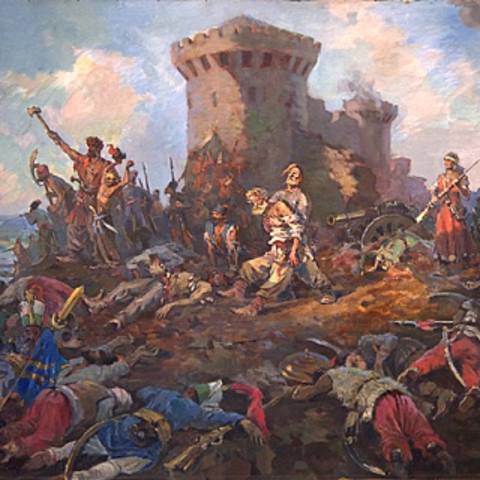
The Don people, having at their disposal an excellent base and free access to the sea, organized a large sea voyage in the summer of 1638. On July 15, 2000 Cossacks in 40 plows went to sea. Cossack ships dispersed throughout the Black Sea, wadders smashed and plundered Trebizond, Sinop, Rize, separate canoes appeared at the Bosphorus. Concerned Turkish government directed against Don fleet the galley squadron under the command of the talented Admiral Piyale Pasha, who trapped and completely destroyed the Cossack flotilla in the Adakhun estuary. The defeat was serious, of the entire ratification that went to the Don, only a few dozen people returned in different ways. The weakening of the Cossack military power due to failure at sea inspired the exploits of the rulers of Taman and Crimea. In the fall, they organized a raid to capture the Azov fortress. However, the cavalry for the assault on the stone walls was useless, and besides, the Cossacks very competently used numerous captured guns in the defense of the city. The enemy horde, having suffered heavy damage in manpower and horses, moved back to the steppe. In winter, refugees marched in droves from the west: Polish troops crushed the uprising in Ukraine, and people fleeing repressions left for thousands of people in Moscow lands, asking for citizenship. Smoked atamans of Zaporizhzhya Cossacks Yakov Ostrenitsa and Andrei Gunya with their few, but well-armed and trained troops sailed on their "seagulls" at the mouth of the Don and settled in Azov. The sudden appearance of a formidable military force in the fortress tipped the scales in favor of the Don Cossacks, which sharply cooled the hot heads of the Turkish and Tatar leaders who longed for revenge for the autumn defeat. For two years, Azov lived a peaceful life, the Don people and their eternal Crimean neighbors-enemies arranged against each other only usual petty “pranks” with the purpose of robbery.
Sultan Murad IV was also not in trouble at the far north-eastern outskirts of the empire. Having victoriously ended the war with Iran with the capture of Baghdad, the Turkish ruler was preparing to oppose his most consistent and implacable enemy - the Knights of Malta. But in 1640, Sultan Murad died unexpectedly, because of which the march to Malta did not take place. His successor, Ibrahim I, did not forget about Azov and, in order to punish roughly the impudent kafir, decided to transfer the Anatolian army, hardened in battles, from Mesopotamia to the Don. Russian agents in Istanbul learned about the intentions of the Turks and immediately reported this to Moscow, and from there the messengers with alarming news rushed to Azov. Moreover, as the Russian scouts reported, the Azov campaign would not be limited, the Turks are going to completely “clean” the entire Don region from the Cossacks, and there it is quite possible to march on Astrakhan, as in 1569 year.
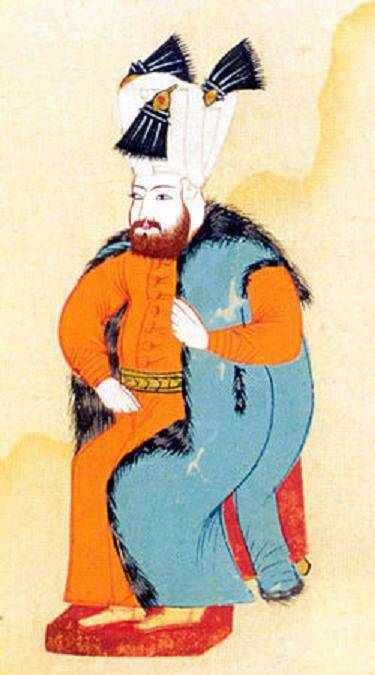
Ivan Katorzhny urgently left the capital from the Monastic Pogost with a request to urgently assist weapons and food, however, being in a difficult diplomatic relationship with Istanbul, the tsarist government was slow. Suddenly, an embassy of Iranian Shah Sefi I led by Maratkan Mamedov appeared in Azov. The Persians offered to make an alliance between Free Don and Iran (after all, officially Moscow had always refused to claim power on the Don) and offered help, promising to send 10 thousands of Askers to participate in the coming war. The Cossacks did not say yes or no, and the Shah ambassador away from sin was taken to Moscow. In the boyar Duma, they were alarmed: Don can naturally swim away into the citizenship of the Shah! The tsarist government immediately allocated necessary reserves to Katorzhny, paid 6 thousands of rubles (an impressive amount for those times) and released them with honors back home. The Cossacks with Moscow money arrived diligently: it was decided to send the whole amount to repair the Azov fortress. Around all three townships the walls were renewed, problem areas were reinforced with “cartilage” - with a mixture of earth and stones up to three fathoms wide. On the walls and towers, the lower, middle and upper battles were "fought."
After spending all the money on construction, and again “remaining smooth, goals and barefoot,” Don Udaltsi, led by Andrei Guney-Cherkashenin on 23-x strugues, went to sea for prey. In the Kerch Strait, an unpleasant surprise awaited the Cossack flotilla. Eightty-large Mediterranean galleys blocked the exit. In the ensuing clash, the Cossacks sank 5 of enemy ships, but almost all the planes were burned or destroyed by artillery fire of the Turks. The scouts who returned from Perekop and Kuban brought alarming news: everywhere the enemy was gathering troops. The captured prisoners confirmed the information that all winter in the Crimea and Temryuk they collected reserves, and the Turks are preparing a large army for the next year to march on the Don. Azov Ataman Naum Vasilyev, having gathered all the information together, on September 10 1640 sent the Cossack sergeant Dementiy Gavrilov to Moscow with the news of the upcoming Turkish attack and an urgent request to take Azov under the royal arm. Boyar Fyodor Sheremetev, who was in charge of the Cossacks, Dementyev verbally reported that the city was running out of supplies, not enough gunpowder, the exit from Azov to the Black Sea was closed, and despite the repairs, the fortress walls often deteriorate because “many places made stone with earth. And that places and towers have made flags long since, and those places are strong, and according to estimates, now in Azov there are all kinds of thousands of people with five. ” Having received such unhappy information, Tsar Mikhail ordered to give the Don Army five thousand quarters of flour, cereals and other supplies. A caravan with money and a “powder potion” was sent from Voronezh with water. But this time too, Tsar Mikhail Fedorovich diplomatically kept silent about his decision on the Azov issue.
Nevertheless, the Cossacks of Moscow’s interest were understood correctly, they gathered the Big Circle, by a majority vote they decided to “stand behind Azov firmly” and send out a diploma on behalf of the circle, so that everyone could 1641 before Easter, “go to Azov under siege, and whoever doesn’t come, rob and water the plant. However, complete agreement in the Cossack camp, even in the face of a real threat of complete extermination, was not achieved, for example, the Cossacks of Cherkassy and Manych cities refused to go to Azov under siege, saying: “We don’t want to die for a stone!” Of course, most Cossacks the decision was made right: after all, if there is still a war, then the enemy is better to be met in a stone fortress than in the reed walls.
1 March 1641 to Azov arrived ambassadors from the Crimean Khan with a proposal to sell the fortress for a huge amount of gold in 40 000 goldsmiths. The Cossacks refused, saying: “We took the city with our Cossack intent, took it with our heads and our blood. You, the Crimean and Turkish kings, will need the city of Azov, and you will also reach it, just like we, with your heads and your blood. ” In the meantime, disturbing news came again and again from the steppes and from the sea: Tatars and legs gather into the army, Siyavush went out of the Bosphorus — pasha on many ships, carrying troops and siege guns with him. This meant only one thing: a big war on the Don becomes inevitable.
From 7 June 1641, the Cossacks began to gather in Azov, preparing for a long siege. Specially detached teams burned grass and reed in the far outskirts of the city to deprive Turkish and Tatar horses from their pastures. How much it was possibly harvested and brought supplies and other supplies to the citadel, people from the area flowed under the protection of the fortress walls. The city was cleaned by the existing and re-arranged new wells. Townsmen-diggers worked around the clock, wolf pits were rummaging around the fortress, secret underground passages were built, rumors were made to detect enemy tunnels, powerful land mines were installed on threatening directions, the benefit of gunpowder received from Moscow was in prosperity. The Cossacks significantly raised and strengthened the ramparts, prepared tours and log cabins for emergency repair of damaged fortifications, gunners examined and repaired the entire available gun "outfit", consisting of 200 different-sized guns.
The Turks were well aware of who they would have to deal with and what their former fortress represented. For the Azov campaign, a huge army was assembled, even in modern times. It tells a direct participant in the Azov events, Turkish official Evliya Çelebi: "Mutesarrif Ochakovo eyyaleta Kenan Pasha and Pasha Rumelia, were carrying 40 thousand Bugeac Tatars, 40 thousand Moldavian and Wallachian horsemen, 20 thousand troops from the villages of Transylvania and 80 thousand fast as the wind Crimean Tatars, marched ". A selected Anatolian army with thousands of experienced soldiers in 47 arrived at the landing party ships. By the order of the Sultan, the vassal North Caucasian highlanders also appeared: “let the highland princes and the Circassians and ten thousand Kabardians come,” the Russian chronicle tells. In the army of the Turkish commander-in-chief of Silistria pasha Gassan Delia, there was also a six-thousand squad of European mercenaries, masters of "urban combat", led by two German colonels. Елelebi reports the number of the Sultan's army in the 267 of thousands of warriors, such a number of troops assembled seems unreal. But this information is confirmed by the Cossacks in their "Story about the Azov siege seat": "And only with Pashi people were under Azov and with the Crimean king according to the lists of their battle-fighting peasant, except fictitious Germans and black men (non-combat workers) and hunters, 256 thousands of people". In his book "The Azov Epic", the domestic historian Lunin also testifies to the authenticity of the data voiced by Chelebi and the Cossacks, referring to the Turkish distribution sheet, which shows 240 salary payments to thousands of Turkish soldiers who were under the Azov summer of 1641. The Turk artillery park consisted of 129 heavy siege guns, firing double-pods, 647 light guns and 32 mortars that hit with incendiary bombs and explosive grenades. From the sea, the Azov blocked the Turkish fleet of 400 units of multi-tonnage vessels, which were still carrying about 40 thousands of well-armed sailors who were ready to provide any assistance to the siege army on the first signal. This armada was opposed by all 5367 people, of whom 800 souls were women and children who lived in the city at the beginning of the blockade. Atamans Naum Vasilyev and Osip Petrov led the defense of Azov.
Early in the morning of 23 on June 1641, noble Tatar and Nogai Murzes approached the city, bringing a message from the sultan's commander-in-chief, Gassan Pasha, with a proposal for surrender. In his letter, the Turkish commander reported that there was no help from the Moscow tsar, he offered to enter negotiations, and in the case of surrender of the fortress he promised free access and thousands of gold tanks with 42. The Cossacks replied: “We do not expect help from Russia. And not with words, but with sabers ready to receive you, uninvited guests. ” The next day, under the Azov, all the vast Turkish troops appeared and completely blocked the city. The Turks energetically set to work, dug trenches all day, equipped artillery positions, and organized a camp. The Cossacks did not wait for the enemies to settle down thoroughly and on the night from 24 to 25 June, ataman Naum Vasilyev led a detachment of volunteers to the sortie. At the same time, from the Don side, the rook army struck the Turkish positions, two weeks earlier deported to the Balysyr area to monitor the Turkish fleet. According to елelebi, “On this night, the rebellious Cossacks, besieged in the fortress, began without a break to beat cannons and guns, six hundred of our people fell.” Such a significant number of those killed speaks of a serious fight, but most importantly, a large detachment broke into the city, increasing the garrison to 7590 people. Meanwhile, taking advantage of the turmoil and confusion in the enemy’s multi-tribal camp, the Cossack Belyai Lukyanov and his five comrades, without hiding, left the fortress, unhinderedly rode through the battle formations of the Turks, dumbfounded by such arrogance, and carrying the news of the arrival of the enemy and asking for help, they brought relief from such impudence to the Turks, and carrying the news of the arrival of the enemy and asking for help, they brought relief from such impudence to the Turks and carrying the news of the arrival of the enemy and asking for help. in Voronezh, in Cherkassk, in Astrakhan, to the Zaporozhtsy brothers to Sich.
Around the clock, on the near and far approaches to the fortress, work was in full swing. The Turks built trenches, bringing them as close as possible to the walls of the city, installed artillery batteries, transported ammunition and foodstuffs from ships. Finally, by 28 Jun all the preparations for the attack were completed. According to Chelebi, "spreading like a Muslim sea army, occupying seventy trenches with seventy cannons - kulyurinami, shahs, salons, - from seven sides imposed a fortress." In all its magnificence, without hiding, the Turkish army took up the position, demonstrating its strength and power. “It was frightening to us from them at that time and anxiously and wonderfully unspeakably at their slender parish of Busurmani could be seen,” says “Poetic tale”. Early in the morning of June 30, Turkish troops openly, without fear of artillery fire, lined up half a verst from the walls of the fortress. “The twelve janissary commanders turned their ranks, and in eight rows they stretched from the Don to the sea and stood so tightly that they could hold hands,” says an eyewitness. The parliamentarians came out of the ranks of the Turkish troops with a proposal on behalf of the Sultan about the surrender and transfer to his service, for which the Donts were promised "great honor and ineffable wealth". The Cossacks responded in their own way: calling the Master of the Faithful "a stinking dog and a thin swineherd", the Donians promised to fight him to death and threatened "soon the whole Don Army to appear under the walls of Istanbul." As soon as the negotiators returned to their camp, Turkish guns immediately rattled: artillery preparation began. In response, the Cossacks' long-range guns struck, trying to suppress the enemy batteries. According to елelebi, the shooting was so strong that "the earth and the sky shook with the roar of cannon firing." Seven o'clock the guns finally fell silent, and the earth shook again, but from a scream of many voices: the attack columns of the Turkish army rushed to the attack with three waves. European mercenaries and selected troops from Transylvania ran in the first rows of the attack, the Janissaries followed them, the rest of the infantry rolled alongside the Janissaries, the Tatar and Nogai horsemen pranced behind their backs.
Serasker Gassan was well aware of the weak points of the Azov fortress and directed the point of impact against the most vulnerable spot in the defense of the town of Topoprakova. The Turks quickly threw fashinnik and logs ditch and rushed to the defensive shaft. Part of the soldiers, with crowbars and axes, went to the fortress gates, trying to destroy them, the rest set up the stairs and, covered with fire by foreign mercenaries who were constantly shooting muskets around everything that was shown on the walls, they climbed onto the walls. And then to this hour the hiding Cossacks fired a volley at close range from all trunks. Stones and logs flew into the heads of the attackers, the Donets cut the enemies with sabers, stabbed them with spears, poured molten tin, tar and boiling water from the walls. According to the chronicle, even a peculiar chemical weapon went to the business - the heated contents of the cesspools, which led to committing several ablutions a day to clean Turks. The burning fetid substance that fell on the body instantly put the soldier out of action. Not paying attention to the losses, the Turks stubbornly went forward. The battle began on the walls. The Cossacks fought back violently, in the stampede it became impossible to act with firearms, the move went knives and daggers, people choked each other's hands. Less than half an hour later, seven hundred selected janissaries were forever left to lie under the walls of the Earthen town, but the disproportionate preponderance of forces made itself felt. Crushed by a simple number of enemy troops, the Cossacks abandoned their positions and ran.
Encouraged by the Turks rushed after them. Near the temple of John the Baptist, the Turkish chauses put up eight banners, beat the drums and began to gather the Janissaries, flushed with the battle, to regroup and immediately attack the citadel of Azov. The European mercenaries also lined up near the church, waiting until the workers of the “black men of Pomeranian and Kafim” were fastened to the ground with the ground to the top to cover the ditch beneath the walls of the citadel. Half an hour later, the work was completed and the winged soldiers of fortune and the Turks, to the beat of the drummers and the roar of the janissary brass band, elated by their first success, lifted the ladder over their heads and moved to the assault. Suddenly, hell broke loose before them. Powerful landmines, nashpigovnymi with iron scraps and sharp stones, simultaneously rushed right through the entire Toprakova town. The Cossacks, knowing full well that they couldn’t hold the weakly fortified fort, staged a fiery trap for the enemy in advance. Almost ten thousand people were killed at once, including all foreign mercenaries with their colonels, six camp commanders of the Janissaries died, many soldiers were injured, burned and contused. Attack of the Turks choked. Osip Petrov immediately took advantage of this. Having passed the cannons to the rear of the enemy troops, which were hidden from the enemy’s eyes, the ataman with a hundred Cossacks struck in the back to the bewildered enemy. From Azov made a sortie garrison. Stunned by the Turks, throwing weapons and banners, rushed to their heels. The Cossacks drove a frantic crowd, once a former army, to the advanced positions of the Turkish army, then, rushing into enemy trenches, staged a bloody bath rushing to the enemy in panic. Noticing that numerous reinforcements are in a hurry from the main camp of the siege army, Osip Petrov gave a signal to withdraw. The Donets retreated in perfect order, thoroughly destroying the enemy positions and taking with them several trophy guns. In the second half of the day, the Turks sent negotiators with a proposal to conclude a truce in order to gather their dead and bury them according to the Muslim custom before sunset, and offered a ransom for the bodies of noble warriors. The Cossacks agreed, because the street was hot, the danger of an epidemic was great, and generously refused the offered money. The rest of the time until dark, the working team of the Turks dug a mass grave and demolished the bodies of their comrades there.
On the morning of June 30, the shelling of the fortress resumed with a new force. Seven days the siege guns of the Turks crushed the walls, towers and ramparts of the fortress. The Cossack gunners tried with all their might to suppress enemy batteries, but the forces were too unequal, and the stock of cores began to come to an end. A few days later the guns of the Don Army were silent, as the chronicler narrates with bitterness that "our cannon outfit has been broken all over." In the citadel all the houses were destroyed, the church of St. John the Baptist was demolished, people huddled in dug underground shelters and in the basements of the stone towers of the Genoese construction, which turned out to be surprisingly strong. The nights of the broken walls of Azov were re-strengthened by previously prepared wooden log houses filled with earth, baskets with soil and the Turkish gunners had to smash them again, using gunpowder and cores. Serasker Gassan Delia to attack Azov used tactics that showed themselves well during the siege of Baghdad. He ordered to build a shaft with a height that exceeded the shaft and the fortress wall of the Toprac town, so that, having installed guns on a hill, direct fire on the fortifications of the defenders of the city. For three days, Turkish excavators wore and rammed the ground, the mound grew higher and higher. The Cossacks understood all the danger from the shaft. "... And we, seeing that high mountain, our eternal grief, that from it our death will be." The Cossack sappers-gorodniki began to lead in advance under the shaft under construction, but the existing stock of powder potion could not destroy such a colossus. Noticing that the Turks on the shaft are already preparing positions for the installation of guns, atamans Petrov and Vasilyev decided to go all-in and strike the Turks with the whole garrison at night, creating a significant advantage in a narrow section of the front.
The ending should ...
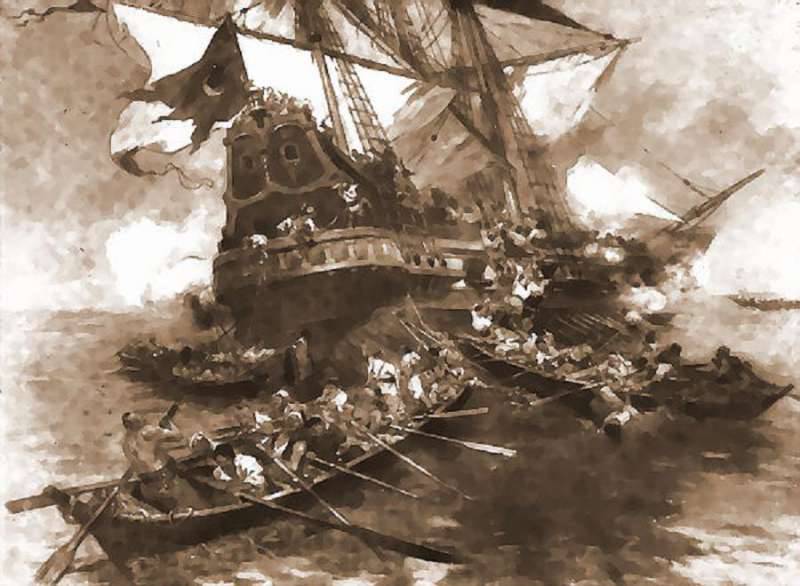
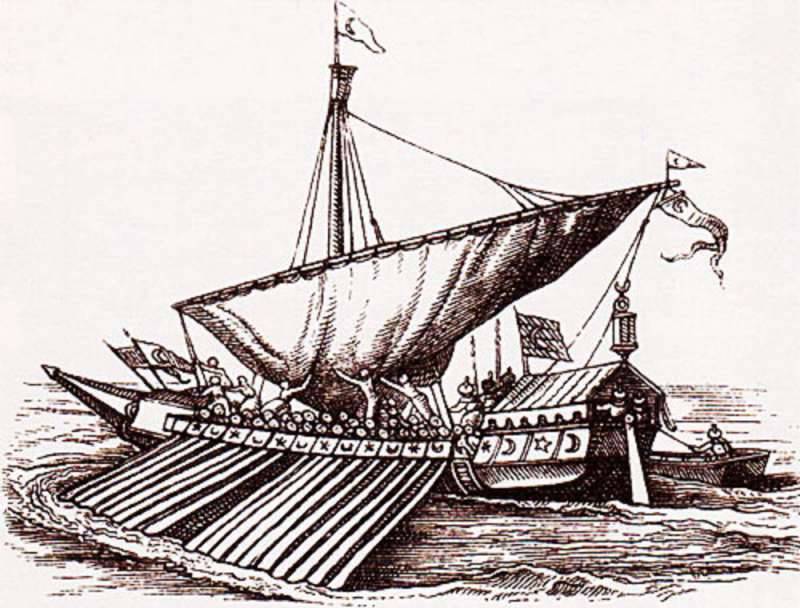
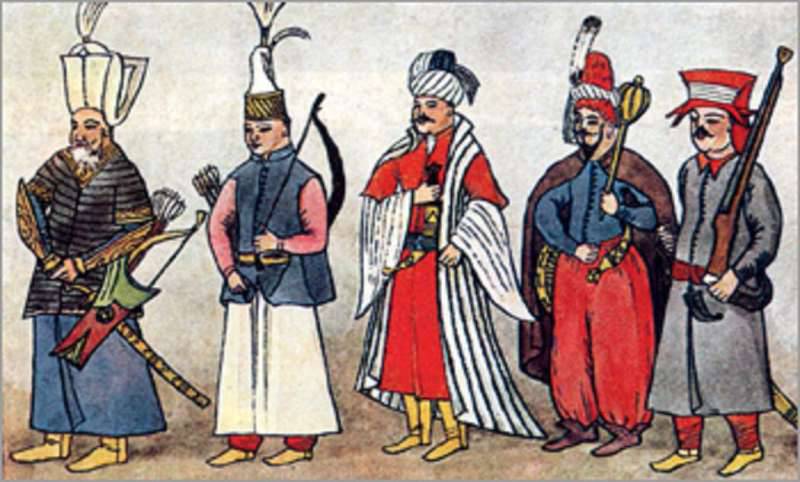
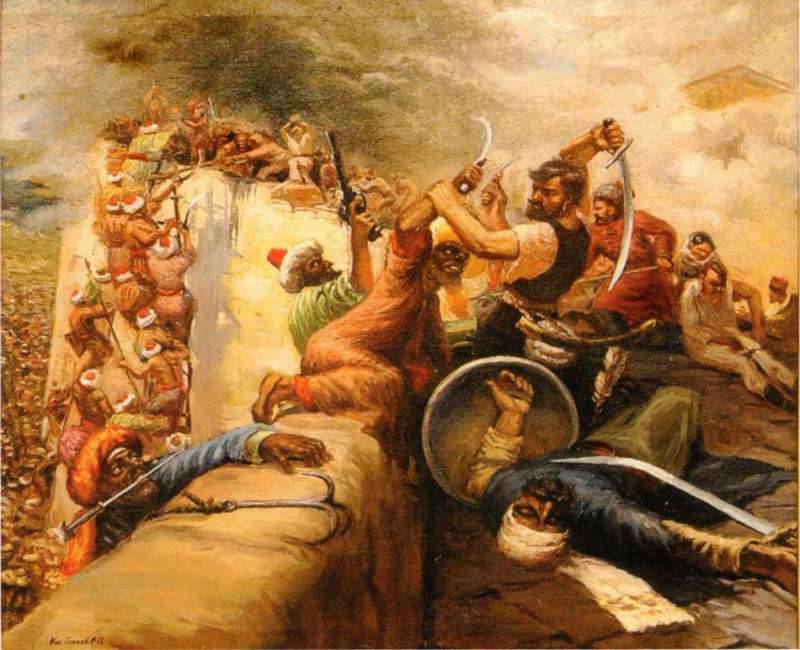
Information